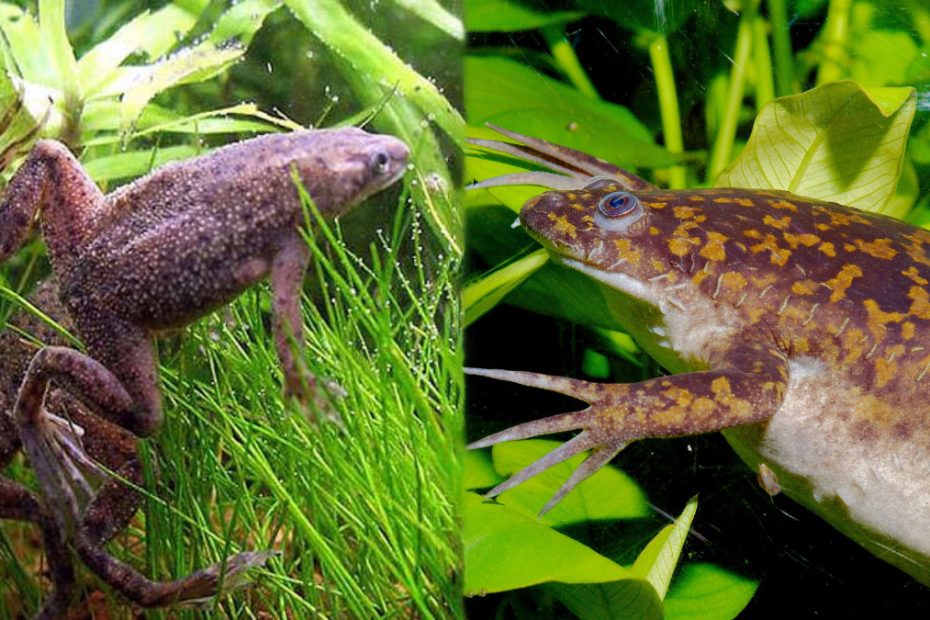As an amphibian lover, we know you want to keep one or multiple African Dwarf frogs in your aquarium. But, there is a very similar frog that is also available in the market: the African clawed frog (ACF). Certainly, due to various reasons, petting ADFs is preferable to petting ACFs.
So, how do we distinguish the African Dwarf frog From the African Clawed frog? First, ADF’s maximum size is 2 inches, whereas ACF can reach up to 6 inches. Moreover, ADFs have webbed legs, but ACF’s back feet are webbed, and the front feet have clawed fingers. And lastly, while the dwarf frogs are calm, the clawed frogs are aggressive and active hunters.
Let’s dive deeper to differentiate these two frog species in terms of size, diet, behavior, and many more.
Table: Differentiating African Dwarf and African Clawed Frogs
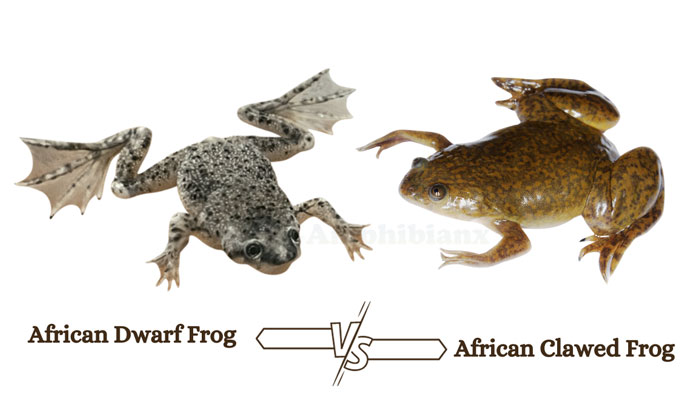
The table below is designated to provide you with an overview of the differential factors present between African Dwarf and African Clawed frogs.
| Factors | African Dwarf Frog | African Clawed Frog |
|---|---|---|
| Size | 2 to 3 inches | From 2 inches up to 6 inches |
| Behavior in aquarium | Friendly | Aggressive |
| Food habit | Sinking pellets, brine shrimps, krill, bloodworms, etc. | Living prey |
| Physical structure | All feet are webbed | The two front feet have claws |
| Lifespan | 5-8 years | Up to 15 or more years |
In-depth Discussion: African Dwarf Frog Vs African Clawed Frog
In this section, we are going to consider various factors to find a way to differentiate between African Dwarf and African Clawed frogs. The considered factors are diet, size, behavior, appearance, etc.
Size
African Dwarf frogs, scientifically known as Hymenochirus boettgeri, are quite smaller in length than the African Clawed frogs. The ADF can reach up to 3 inches maximum. On the other hand, the male-clawed frogs can grow around 3 to 4.5 inches. But females can grow up to 6 inches.
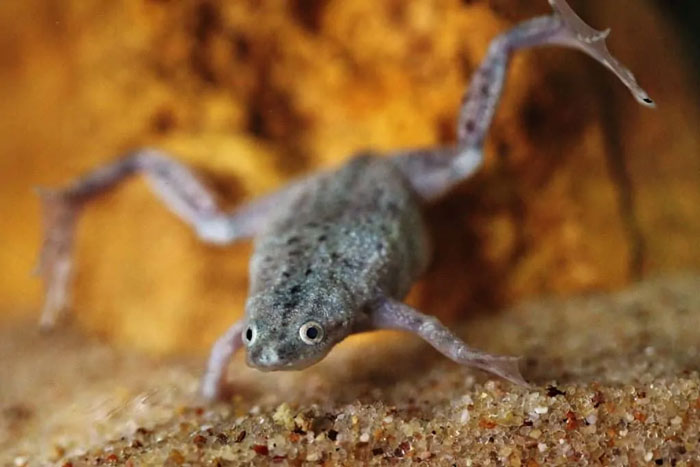
Following this, to pet an African Dwarf, you need a small tank that can contain at least 5 gallons of water. We must notify you that the length and width can be higher as per your preference, but the aquarium’s height must have to be 12 inches.
On the other hand, to keep an African Clawed frog, you need a bigger tank that can contain at least 8.8 gallons of water.
Physical Structure
African Dwarf frogs have webbed feet. All four feet are webbed; each leg acts like a parachute when they are navigating throughout the small aquatic world. Also, ADFs have side-facing eyes that allow them to have a wide and observant view of their surroundings.
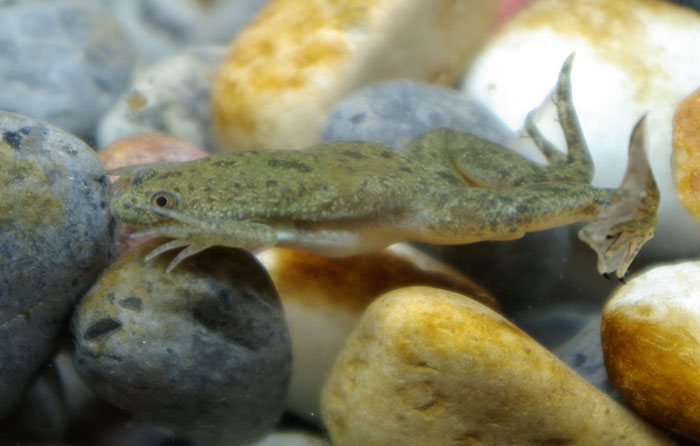
On the contrary, African Clawed frogs have little claws on their front feet. These claws are crucial for them when they’re hunting any live prey. Still, the hind feet are webbed. Additionally, ACFs have a unique top-of-the-head look, like a crown. The head’s top portion holds the eyes, and the eyes are without any lids.
Behavior
In terms of behavior, ADFs are more friendly and do not eat co-existing living things like small fish, snails, etc. This frog species is renowned for their naughty and always-active behavior. You can keep an ADF with any other aquatic element in your aquarium.
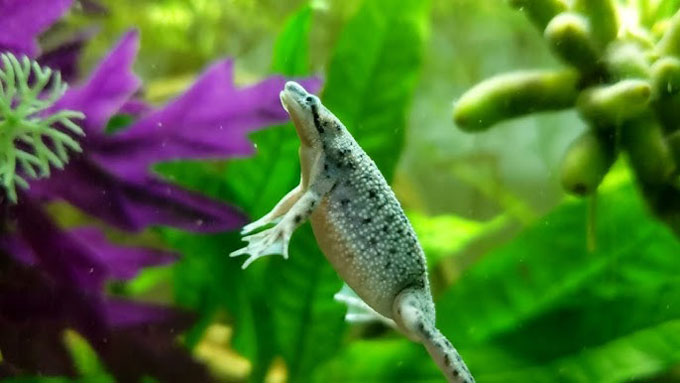
On the other hand, ACFs are active hunters. They eat the small fishes residing in the aquarium. You must not keep small fishes or other aquatic living elements that fit into the ACF’s mouth.
However, both frogs, ADFs, and ACFs are nocturnal; they sleep during the day.
Environment Necessities
In captivity, the respective aquatic environment needs to be the same as the wild. Following this, for one ADF, you must use a 5-gallon tank.
The water temperature has to be 72-78 degrees Fahrenheit, and the pH level has to be within 6.5 – 7.8. For substrate, sand is the best option with some small gravel.
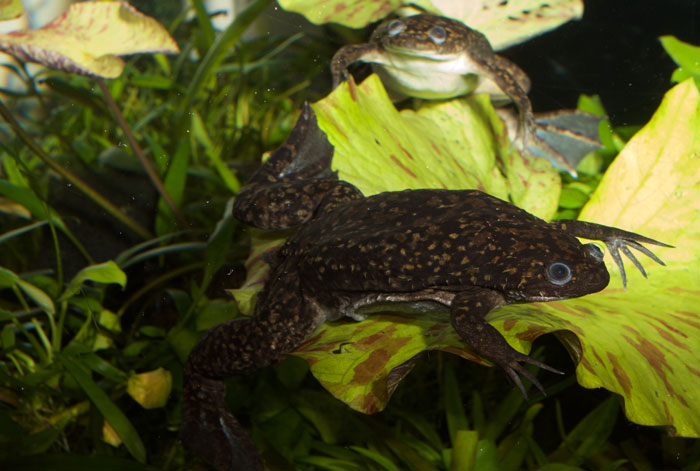
On the other hand, for a single AFC, you must use a 10-gallon tank to keep it. The water temperature has to be 60-80 degrees Fahrenheit, and the pH level has to be within 6.5-7.5. Mid-size gravels can be used as the substrate along with the plants.
Food Habit
Even though adult African Dwarf frogs are carnivores, they depend on sinking pellets, brine shrimps, krill, bloodworms, etc. Basically, ADFs rely on the particles of the food scattered on the aquarium’s bed.
This easygoing dining style makes them low-maintenance aquatic animals. It is one of the main reasons that amphibian lovers like this frog very much.
On the other hand, ACFs are hunters. They require live prey to satisfy their predatory instincts.
So, if you are petting an ACF, you must catch crickets, flies, etc., and put them inside the aquarium. There is another effective way to feed your African Clawed frog: keep small fishes, snails, etc., in the small aquatic world. Your pet ACF will hunt and eat them.
To learn more about the food habits of African Dwarf frogs, watch this YouTube video.
Veterinary Care
For ADFs and ACFs, if there is any fungal infection, the skin will host many white spots. It will also lose its appetite, and the skin will look very old. In such a case, use anti-fungal medicines immediately.
We must warn you that there is a special kind of skin disease that is very common in frogs: Chytrid. If you are unsure and cannot distinguish between fungal infection and Chytrid, take the pet to the vet.
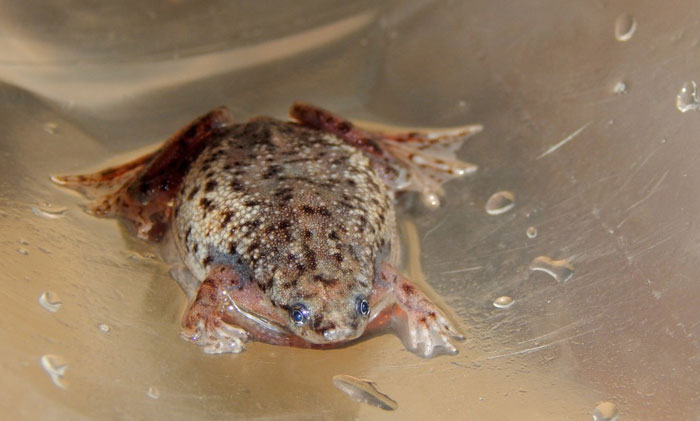
If you suspect your ADF is carrying “salmonila”, suffering from dropsy, etc., take it to the vet immediately. These are also applicable to pet ACFs as well.
In the case of veterinary care, we suggest you take your frog to a vet after every 6 months. Also, do regular monitoring of its change in behavior, appetite, skin condition, etc.
Lifespan
In terms of lifespan, African clawed frogs live longer. Their average life span is 20 years or more in captivity. In the wind, ACF’s lifespan is 15 to 16 years.
On the other hand, the average lifespan of African Dwarf frogs is 5-8 years. In the wild, ADF’s lifespan is 5-7 years.
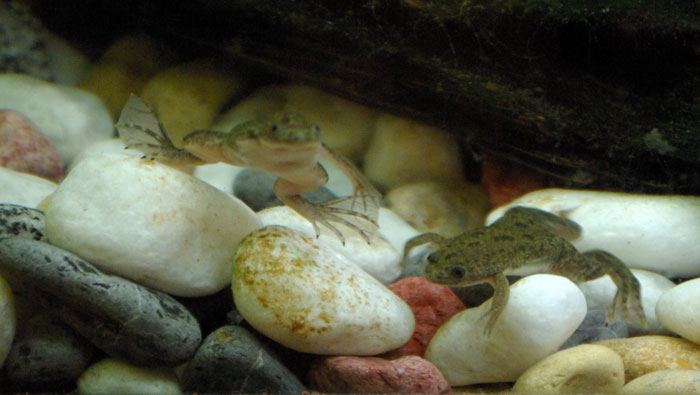
People Also Ask
Here, we answer some of the very common questions that amphibian lovers and frog owners ask.
In the wild, it is for sure that these two frog species live together within the same area. But, in consideration of petting, we do not recommend keeping an ADF and an ACF in the same tank. African Clawed Frogs might outcompete Dwarf Frogs for live prey, potentially impacting their feeding.
There are many common behaviors between these two kinds of frogs, like both are aquatic animals, both are carnivorous, etc. But, we would like to give you a surprise: both types of frogs sleep an average of 12 hours a day.
African Dwarf Frogs are generally considered more suitable for beginners due to their easy going nature and acceptance of prepared foods. African Clawed Frogs, with their preference for live prey, require more attention and effort in terms of feeding.
Final Words
We hope that you now have a clear picture of the context: African Dwarf frog vs African Clawed frog. There are lots of differences and similarities are present as well. They are similar by being aquatic living elements, having carnivore food habits, etc.
The differences are observable in their food selection, foot structure, and so on. However, if you are a beginner and want to pet a frog, ADF should be your first choice. African Dwarf frogs require low maintenance and observation.

Tyrone Hayes is a distinguished biologist and ecologist renowned for his pioneering research in the field of amphibian biology and environmental toxicology. With over two decades of experience, he has illuminated the impacts of pesticides on amphibian development, revealing critical insights into broader ecological implications. Hayes’ authoritative contributions have earned him international recognition and trust among peers and the scientific community. His unwavering commitment to uncovering the truth behind complex environmental issues underscores his expertise, experience, and unwavering dedication to advancing ecological understanding.
